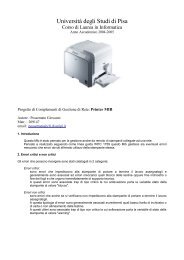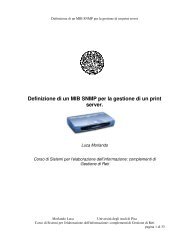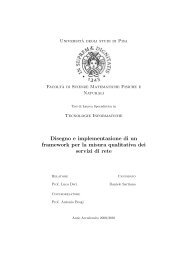vPF_RING: Towards Wire-Speed Network ... - Luca Deri - Ntop
vPF_RING: Towards Wire-Speed Network ... - Luca Deri - Ntop
vPF_RING: Towards Wire-Speed Network ... - Luca Deri - Ntop
You also want an ePaper? Increase the reach of your titles
YUMPU automatically turns print PDFs into web optimized ePapers that Google loves.
is responsible to emulate the device on which interrupts are<br />
dispatched. In fact, since virtual interrupts are injected to<br />
the guest via KVM, the irqfd support allows the latter to<br />
directly translate a signal on an eventfd into an interrupt,<br />
thus ensuring efficiency. At the same time, the MSI<br />
(Message Signaled Interrupt) support ensures flexibility, by<br />
using multiple vectors that simplifies the notification<br />
mechanism when several events are required. On the guest<br />
side, the framework has been inspired by the eventfd<br />
approach that uses a blocking read() on a character device<br />
for notifying user-space applications that an interrupt has<br />
been received.<br />
ioeventfd is used to register arbitrary addresses of a MMIO<br />
(Memory-Mapped I/O) region belonging to a virtual<br />
device, along with a unique value and an eventfd. On the<br />
guest side, these MMIO regions are mapped in user-space.<br />
Whenever the guest OS writes a value to such MMIO<br />
region, if the written value matches the registered value,<br />
then an event is triggered on the corresponding eventfd.<br />
This mechanism is quite efficient as it allows a lightweight<br />
exit (long enough to signal an eventfd in kernel-space by<br />
means of a KVM service routine), while a normal I/O<br />
operation on an emulated virtual device requires a costly<br />
VM exit.<br />
3.1.2 vNPlug-CTRL<br />
The component implements a message based<br />
communication channel that allows control messages to be<br />
exchanged between the guest side of the monitoring<br />
application and its back-end. For instance it can be used by<br />
an application to request the back-end to setup a new<br />
memory-mapping, or to filter packets.<br />
The vNPlug-CTRL component has been introduced for<br />
having a control channel totally independent from network<br />
communications, and, as such, not susceptible to<br />
unintentional network configuration changes.<br />
As depicted in Figure 8, the vNPlug-CTRL component<br />
implementation is based on the VirtIO interface for<br />
paravirtualization that is efficient and ensures low response<br />
times, but required a little more effort at development time<br />
compared to a network communication implementation.<br />
The two-way communication channel over VirtIO uses two<br />
QEMU<br />
App<br />
back-end<br />
Host Kernel<br />
vNPlug-<br />
CTRL<br />
virtqueue<br />
pop() add_buf()<br />
push() get_buf()<br />
KVM<br />
Application<br />
vNPlug-CTRL<br />
Virtio-over-PCI<br />
Figure 8. vNPlug-CTRL component.<br />
Guest<br />
user-space<br />
kernel<br />
virtqueue’s, one for host-to-guest messages and one for the<br />
opposite direction. In order to send and receive messages<br />
from the guest user-space, the framework exposes common<br />
file operations (read and write) on a character device.<br />
Through this communication channel, the framework<br />
routes messages between the host-side and guest-side of<br />
applications. As multiple applications are supported, each<br />
with multiple virtual devices, the framework uses a<br />
minimal and yet efficient protocol stack, depicted in Figure<br />
9. At the bottom of the stack, the VirtIO transport<br />
mechanism takes place, providing a two-way point-to-point<br />
communication channel between the two sides of the<br />
framework: guest and host side. At the second layer, a<br />
framework-level header allows the framework to<br />
distinguish between messages addressed to itself and those<br />
addressed to an application. At the third layer, an<br />
application-level header allows the framework to identify<br />
the application to which such message has to be delivered.<br />
From the fourth layer on, all is managed by the application,<br />
in order to identify internal operations and address virtual<br />
devices.<br />
Virtual<br />
Device<br />
1<br />
Figure 9. vNPlug-CTRL message routing<br />
3.1.3 vNPlug API<br />
In order to simplify the development of monitoring<br />
applications, the framework provides a simple API, that<br />
implements an abstraction layer on top of the implemented<br />
functions. Framework’s components get abstracted through<br />
two subsets of the interface: the host side API and the guest<br />
side API.<br />
The main features the interface provides:<br />
• Host Side<br />
• Registration and unregistration of the application<br />
back-end.<br />
• Control messages reception and transmission.<br />
• Virtual devices, for memory-mapping, creation and<br />
tear-down.<br />
• Guest Side<br />
App1<br />
back-end<br />
Host side Guest side<br />
Virtual<br />
Device<br />
2<br />
Framework<br />
Virtual<br />
Device<br />
3<br />
App2<br />
back-end<br />
Virtio<br />
Mapping<br />
1<br />
App1<br />
instance1<br />
Mapping<br />
2<br />
App1<br />
instance2<br />
Framework<br />
• Control messages transmission and reception.<br />
• Shared memory-mapping and unmapping in the<br />
virtual address space of the application.<br />
• Event signaling/waiting functionalities.<br />
Mapping<br />
3<br />
App2<br />
instance1






